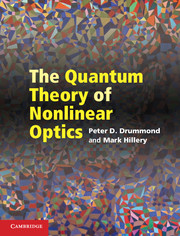Book contents
- Frontmatter
- Contents
- Preface
- Introduction
- 1 Classical nonlinear optics
- 2 Field quantization
- 3 Quantized fields in dielectric media
- 4 Microscopic description of media
- 5 Coherence and quantum dynamics in simple systems
- 6 Decoherence and reservoirs
- 7 Phase-space distributions
- 8 Single-mode devices
- 9 Degenerate parametric oscillator
- 10 Quantum field dynamics
- 11 Quantum propagation in fibers and waveguides
- 12 Quantum information
- List of symbols
- Index
- References
6 - Decoherence and reservoirs
Published online by Cambridge University Press: 05 May 2014
- Frontmatter
- Contents
- Preface
- Introduction
- 1 Classical nonlinear optics
- 2 Field quantization
- 3 Quantized fields in dielectric media
- 4 Microscopic description of media
- 5 Coherence and quantum dynamics in simple systems
- 6 Decoherence and reservoirs
- 7 Phase-space distributions
- 8 Single-mode devices
- 9 Degenerate parametric oscillator
- 10 Quantum field dynamics
- 11 Quantum propagation in fibers and waveguides
- 12 Quantum information
- List of symbols
- Index
- References
Summary
For the next several chapters we will mainly be focusing on the behavior of a medium with nonlinear susceptibility in an optical cavity. This will entail a detour through the quantum theory of open systems. All physical systems are coupled to the ‘outside world’ to some extent. We call such a system an open system, and the part of the ‘outside world’ that is coupled to it is called a reservoir. If the coupling is very weak, we can ignore it and treat the system as closed.
For the systems of interest here, we must take the coupling to the outside world into account, and, in particular, we need a way to see how this coupling affects the dynamics of the system itself. In the case of a nonlinear medium in a cavity, some of the light leaves the cavity, so the light inside the cavity is coupled to modes outside the cavity. In addition, in order to measure a system, we have to couple it to another system. There are two main ways of treating open quantum systems, namely quantum Langevin equations and master equations. Both methods will be treated here.
Reservoir Hamiltonians
Now let us begin our analysis of open systems. We have a system with degrees of freedom in which we are interested, but these degrees of freedom are coupled to excitations or modes about whose detailed dynamics we do not care. These degrees of freedom in which we are not interested are called reservoirs.
Information
- Type
- Chapter
- Information
- The Quantum Theory of Nonlinear Optics , pp. 184 - 216Publisher: Cambridge University PressPrint publication year: 2014
